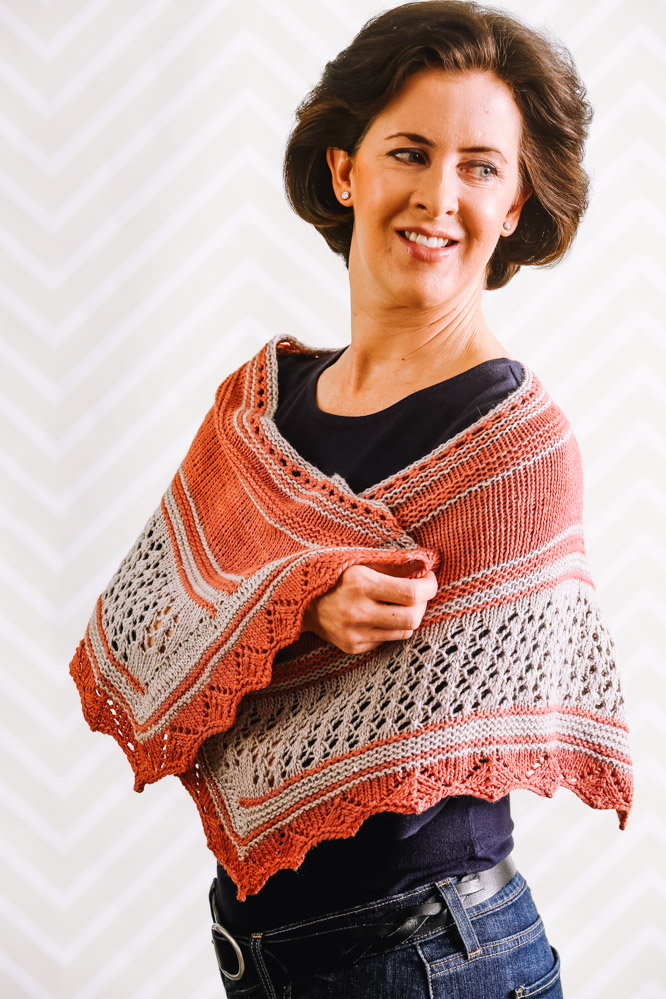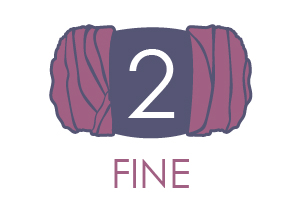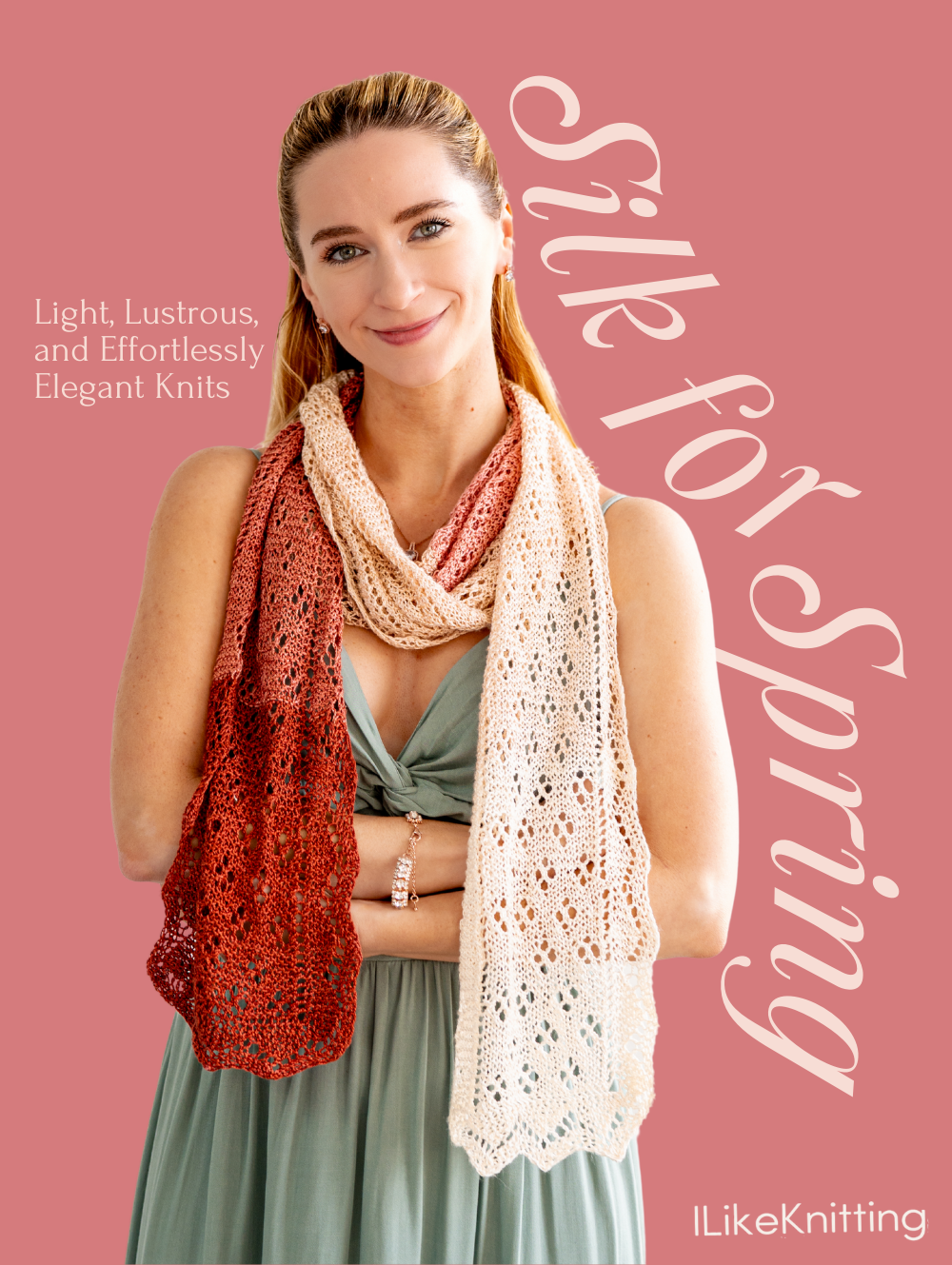
The Coral Sands Shawl is a beautifully wearable, V-shaped wrap that drapes effortlessly around your shoulders, making it a versatile addition to any wardrobe. Designed to be easier to style than crescent or half-circle shawls, this pattern begins with a delicate lace edging that frames the lower and side edges. As you knit, gentle decreases create the signature V shape, enhancing the shawl’s structure and wearability. Lacy stripes with varying textures add depth and interest, making this design a perfect showcase for a hand-dyed or tonal yarn. Whether layered over a casual outfit or worn as an elegant accent piece, the Coral Sands Shawl is a stunning combination of beauty and simplicity.
Skill Level: Intermediate
Size: 54 (64)” [136 (160) cm] along lower edge and 14 (16)” [35 (40) cm] deep, after blocking
Gauge: 19 sts = 4” [10 cm] in stockinette stitch after blocking (gauge is not crucial)
Materials
 Yarn: Swans Island Sport (50% merino wool, 50% tussah silk; 175 yards [160 meters]/50 grams): Guava (MC, 2 skeins), Fog (CC, 2 skeins)
Yarn: Swans Island Sport (50% merino wool, 50% tussah silk; 175 yards [160 meters]/50 grams): Guava (MC, 2 skeins), Fog (CC, 2 skeins)
Needles: US size 6 (4.0 mm) circular needle (24” or 32” [60 or 80cm])
Notions: Stitch markers, 30 (36) of one kind (type 1), 4 of a different kind (called Contrast Markers – CM), scrap yarn, tapestry needle
Abbreviations
K3tog: Knit 3 sts together
S2KP: Sl 2 sts kw, k1, psso; 2 sts decreased
SK2P: Sl 1 st, k2tog, psso; 2 sts decreased
Special Stitches
Lace Pattern for Chart 1 (multiple of 10 plus 11 sts)
Row 1 (WS): Knit.
Row 2: K2tog, k3, yo [K1, yo, k3, sk2p, PM, k3, yo] to last 6 sts, k1, yo, k3, k2tog.
Row 3 and all odd numbered rows: Purl.
Row 4: K2tog, k2, yo, k1 [K2, yo, k2, sk2p, PM, k2, yo, k1] to last 6 sts, k2, yo, k2, k2tog.
Row 6: K2tog, k1, yo, k2 [K3, yo, k1, sk2p, PM, k1, yo, k2] to last 6 sts, k3, yo, k1, k2tog.
Row 8: K2tog, yo, k3 [K4, yo, sk2p, PM, yo, k3] to last 6 sts, k4, yo, k2tog.
Lace Pattern for Alternate Chart 1 (multiple of 10 sts)
Row 1 (WS): Knit.
Row 2: [K1, yo, k3, sk2p, PM, k3, yo].
Row 3 and all odd numbered rows: Purl.
Row 4: [K4, sk2p, PM, k3].
Row 6: [K2, yo, k1, sk2p, PM, k1, yo, k1].
Row 8: [K3, sk2p, PM, k2].
Pattern Notes
When you first cast on, you will have 301 (361) stitches in 5 sections: right-hand vertical edge; right-hand lower edge; center lower edge, left-hand lower edge; and left-hand vertical edge. Each of these 5 sections is divided by a corner where it turns at a 135 degree angle. The angle is created by working decreases.
After the edging is worked, you will place the right-hand vertical edge stitches and the left-hand vertical edge stitches on scrap yarn and continue working just the 3 lower edge sections, (with a much smaller stitch count).
Pattern
Cast on 301 (361) sts in MC.
Setup Row: Knit, placing regular markers at every repeat of lace patt, i.e. after st 5, st 15, st 25, etc. Place Contrast Markers (CM) at corners, i.e. after st 55 (65), 115 (145), 175 (205), 235 (285).
Section 1
Work Rows 1-9 of Chart 1, using Corner Chart 1 just after each Contrast Marker (each corner).
You may remove the regular markers.
Row 10 [RS]: Using CC, knit to end. (285 (345) sts)
Row 11: Using CC, knit to end.
Row 12: Using MC, [k to CM, k2, sk2p, k1] 4 times, k to end. (277 (337) sts)
Row 13: Using MC, knit.
Row 14-15: Same as Row 10-11.
Row 16: Using CC, k 55 (65) sts, and place these sts on a piece of scrap yarn. [K to CM, k1, sk2p] 4 times, k to end. Place the last 56 (66) sts (just knitted) on scrap yarn, removing the last CM, cut yarn with a 120” [300 cm] tail (this yarn will be used for finishing). (158 (198) sts)
Note: The 2 bits of knitting on scrap yarn will later be attached along the vertical edges of the shawl. (For now, you may pin them to the shawl so they don’t get in the way.)
Reattach yarn at last st on needle.
Section 2
Row 17 [WS]: Using CC, knit to last 2 sts, k2tog. (157 (197) sts)
Row 18 [RS]: Knit.
Row 19: Knit.
Row 20: Using MC, kfb, [k to CM, sk2p, k1] 2 times, k till 2 sts remain, kfb, k1. (155 (195) sts)
Row 21: Knit.
Row 22: Using CC, knit.
Row 23 and all WS rows in this section: Purl.
Note: you may want to move the CMs out of the way.
Switch to CC for Rows 24-45.
Row 24: Kfb, k2(4), [work row 2 of Chart 2] 8 (11) times, sk2p, k2, [work row 2 of Chart 2] 7 times, k2, sk2p, [work row 2 of Chart 2] 8 (11) times, k2(4), kfb, k1. (153 (193) sts)
Row 26: K4(6), [work row 4 of Chart 2] 8 (11) times, k3, [work row 4 of Chart 2] 7 times, k3, [work row 4 of Chart 2] 8 (11) times, k5(7).
Row 28: Kfb, k3(5), [work row 2 of Chart 2] 8 (11) times, sk2p, [work row 2 of Chart 2] 7 times, sk2p, [work row 2 of Chart 2] 8 (11) times, k3(5), kfb, k1. (151 (191) sts)
Row 30: K5(1), [work row 4 of Chart 2] 8 (12) times, k1, [work row 4 of Chart 2] 7 times, k1, [work row 4 of Chart 2] 9 (12) times, k0(2).
Row 32: Kfb, k4(0), [work row 2 of Chart 2] 7 (11) times, k5, sk2p, k2, yo, S2KP, yo, [work row 2 of Chart 2] 5 times, k5, sk2p, k2, yo, S2KP, yo, [work row 2 of Chart 2] 7 (11) times, k4(0), kfb, k1. (149 (189) sts)
Row 34: K6(2), [work row 4 of Chart 2] 8 (12) times, k5, [work row 4 of Chart 2] 6 times, k5, [work row 4 of Chart 2] 8 (11) times, k1(3).
Row 36: Kfb, k5(1), [work row 2 of Chart 2] 7 (11) times, k4, sk2p, k1, yo, S2KP, yo, [work row 2 of Chart 2] 5 times, k4, sk2p, k1, yo, S2KP, yo, [work row 2 of Chart 2] 7 (11) times, k5(1), kfb, k1. (147 (187) sts)
Row 38: K1(3), [work row 4 of Chart 2] 9 (12) times, k3, [work row 4 of Chart 2] 5 times, k3, [work row 4 of Chart 2] 9 (12) times, k2(4).
Row 40: Kfb, k0(k2), [work row 2 of Chart 2] 8 (11) times, k3, sk2p, yo, S2KP, yo, [work row 2 of Chart 2] 5 times, k3, sk2p, yo, S2KP, yo, [work row 2 of Chart 2] 8 (11) times, k0(2), kfb, k1. (145 (185) sts)
Row 42: K2(4), [work row 4 of Chart 2] 8 (11) times, yo, S2KP, place CM, yo, k4, [work row 4 of Chart 2] 5 times, yo, S2KP, place CM, yo, k4, [work row 4 of Chart 2] 8 (11) times, k3(5).
Section 3
Note: Work the sk2p using the 3 sts after the CM. After working the sk2p, move the marker to sit one st before the sk2p st.
Do this for every Decrease Row for the rest of the shawl. This allows the sk2p stitches to line up above each other.
Row 44: Using CC, kfb, [k to CM, sk2p] 2 times, k till 2 sts remain, kfb, k1. (143 (183) sts)
Row 45: Purl.
Row 46: Using MC, knit.
Row 47: Knit.
Row 48: Using CC, kfb, [k to CM, sk2p] 2 times, k till 2 sts remain, kfb, k1. (141 (181) sts)
Row 49: Knit.
Row 50: Using CC, knit.
Row 51: Knit.
Row 52: Using MC, kfb, [k to CM, sk2p] 2 times, k till 2 sts remain, kfb, k1. (139 (179) sts)
Row 53: Knit.
Row 54: Using MC, knit.
Row 55: Knit.
Row 56: Using CC, kfb, [k to CM, sk2p] 2 times, k till 2 sts remain, kfb, k1. (137 (177) sts)
Row 57: Knit.
Row 58: Using MC, knit.
Row 59: Purl.
Row 60: Using MC, kfb, [k to CM, sk2p] 2 times, k till 2 sts remain, kfb, k1. (135 (175) sts)
Row 61: Purl.
Rows 62-77: Repeat Rows 58-61, 4 more times. (127 (167) sts)
Row 78: Using CC, knit.
Row 79: Knit.
Row 80: Using MC, kfb, [k to CM, sk2p] 2 times, k till 2 sts remain, kfb, k1. (125 (165) sts)
Row 81: Knit.
Row 82: Using MC, *k2tog, yo, rep from * to last st, k1.
Row 83: Knit.
Row 84: Using MC, kfb, [k to CM, sk2p] 2 times, k till 2 sts remain, kfb, k1. (123 (163) sts)
Row 85: Knit.
Row 86: Using MC, knit.
Row 87: Purl.
Row 88: Kfb, [k to CM, sk2p] 2 times, k till 2 sts remain. Kfb, k1. (121 (161) sts)
Row 89: Purl.
Rows 90-91: Using CC, knit.
For Smaller Size Only
Row 92: Using CC, k to end.
For Larger Size Only
Row 92 – Using MC, Kfb, [k to CM, sk2p] 2 times, k till 2 sts remain. Kfb, k1. (159 sts)
Row 93: Using MC, knit.
Rows 94-95: Using CC, knit.
Row 96: Using MC; Kfb, [knit to CM, sk2p] 2 times, k till 2 sts remain. Kfb, k1. (157 sts)
Row 97: Using MC, knit.
Row 98: Using MC, *k2tog, yo, rep from * to last st, k1.
Row 99: Using MC, knit.
Row 100: Using CC, Kfb, [k to CM, sk2p] 2 times, k till 2 sts remain. Kfb, k1. (155 sts)
Row 101: Knit.
Row 102: Using CC, knit.
Both Sizes
Bind off very loosely on WS, preferably using a stretchy bind-off. Note: Try using a needle 2 or 3 sizes bigger (if needed) to get a loose bind-off.
Finishing
There are 3 options for attaching the edging strips to the vertical edges of the shawl. Choose the one you like best. Option 2 is the most invisible join; Option 3 adds a decorative accent.
Use the yarn that was reserved in Row 16 for finishing.
Option 1: Sew the edging strips to the vertical edges of the shawl.
Option 2: With RS facing, working along right-hand side vertical edge, pickup and knit 55 (65) sts. Transfer sts from scrap yarn to another needle [hint: a yarn needle helps with this.]
Use Kitchener Stitch (grafting) to join the 2 pieces, starting with the top. Repeat for the left hand side vertical edge, this time with 56 (66) sts.
Option 3: With RS facing, working along right-hand side vertical edge, pickup and knit 55 (65) sts. Transfer sts from scrap yarn to another needle [hint, a yarn needle helps with this.]
Use 3 Needle Bind off to join the 2 pieces, starting with the top. Repeat for the left hand side vertical edge, this time with 56 (66) sts.
Weave in ends. Block to desired measurements and trapezoidal shape, blocking out the points of the edging.


